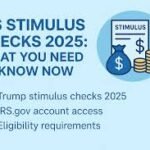Workers across several states will see higher paychecks this month.
The United States is set for another wave of minimum wage increases starting October 2025, following the rollout of the “One Big Beautiful Bill” (OBBB) economic package. While the federal minimum wage remains unchanged at $7.25 per hour, more than 30 states are implementing higher rates to help offset inflation and support working families.
According to the Department of Labor (DOL), these adjustments will directly impact over 20 million workers, particularly in industries like retail, hospitality, and personal services—sectors most affected by rising living costs.
A Boost Amid Economic Pressure
The wage hikes arrive as many households struggle with higher housing costs and inflation-driven price increases. Economist Marcia Reynolds from Georgetown University explains that raising the minimum wage “not only ensures fair pay, but also strengthens local economies through increased consumer spending.”
Government projections from the Congressional Budget Office (CBO) estimate that the new rates could inject $25 billion into the U.S. economy each year and lift nearly 900,000 people out of poverty by 2026.
States Leading the Increase
Several states are setting new benchmarks for minimum pay:
- Washington: $17.95 per hour
- California: $16.50 per hour
- New York: $16.00 per hour
Others—including Florida, Connecticut, Delaware, and Oregon—will apply smaller, inflation-linked adjustments based on the Consumer Price Index (CPI). By the end of 2025, over half of U.S. states are expected to have a minimum wage above $14 per hour.
What Employers Need to Know
The DOL will intensify oversight to ensure compliance under the Fair Labor Standards Act (FLSA). Employers are advised to update payroll systems, labor notices, and contracts in line with new rates. They should also review union agreements and maintain accurate pay records, as audit activity is expected to rise before the year ends.
A Step Toward Fairer Pay
Experts view the state-level increases as a move toward a more balanced and competitive labor market. “A living wage is not a cost—it’s a commitment to economic strength,” said Kendra Lopez, senior policy advisor at the Economic Policy Institute.
While the debate over raising the federal minimum wage continues, the October 2025 increases represent meaningful progress toward improving living standards for millions of American workers.

